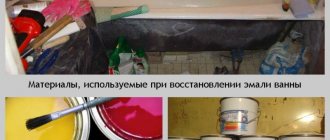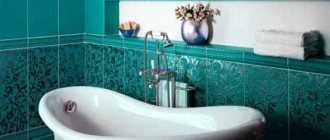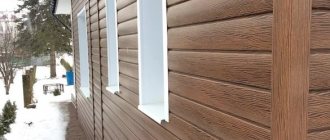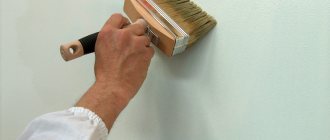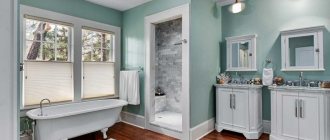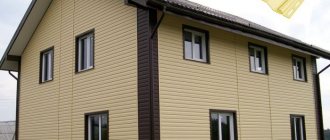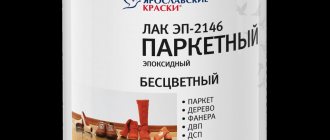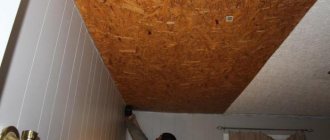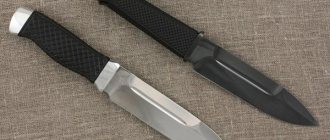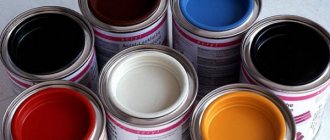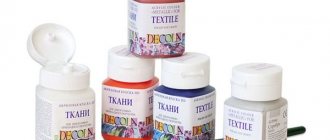Sooner or later everything falls into disrepair. This applies not only to things, but also to plumbing equipment. The bathtub, which just recently shone with whiteness, after some time will inevitably turn yellow, lose its gloss and become covered with a network of cracks.
Agree, a complete replacement of plumbing fixtures is a costly and troublesome undertaking. If the integrity of the bowl is preserved, you can extend its service life by repainting the surface of the bathtub. This service can be ordered from a specialized company or you can do the work yourself. The main thing is to choose a high-quality composition.
Before choosing enamel for bathtub restoration, you need to find out more information about the products available in plumbing stores. We have described in detail the pros and cons, as well as the specifics of applying different compositions.
To make it easier for you to make a choice, we suggest that you familiarize yourself with a review of popular enamels that have received a lot of positive feedback from consumers. Among them are products of domestic and foreign companies.
What you need to know about enamels
There are a lot of enamel restorers for baths. They differ not only in composition, but also in the method of application.
The enamel can be applied to the base with a brush or roller. In this case, the composition should be quite thick. It is best to use a hard brush to make it easier to rub the enamel over the base. It is advisable that the bristles do not come out of the brush; this will ruin the attractive appearance of the bowl.
Using a roller makes it easier to apply enamel. It distributes the composition as evenly as possible, but it is impossible to completely process the entire bowl with a roller. Where it bends you will need a brush.
Another method of applying enamel is spraying. Professionals most often use a spray gun in their work. A liquid composition is poured into it, which is applied in several layers. For non-professionals, this option is often unacceptable due to its complexity.
Perhaps the best way to apply enamel for bathtub restoration is to use a spray gun. This is exactly how experienced professionals work
You can use an aerosol can with special enamel. When applied correctly, the result is a fairly durable and uniform coating. If the work is carried out incorrectly, the coloring may be uneven and spots of different shades will appear on the surface of the bowl.
Some experts believe that enamel in the form of an aerosol is best used to mask small defects, but not to restore the entire bathtub.
When purchasing a product, you should pay attention to its contents. It's best if it includes a bowl pre-treatment, perhaps even a special application tool.
It is advisable that the kit includes tinting compounds that allow you to obtain any desired shade. If you purchase two-component enamel, you should look at the color of the hardener. Dark colors are not recommended. They can impart an undesirable tint to the finished product.
Brief summary
The comparative analysis carried out shows that, in principle, the question of how to cover a bathtub, acrylic or enamel, should not arise. The slightly higher cost of acrylic coating (about 800 rubles) pays off with a service life of at least 2 times longer. If the cost of repairs is broken down by year, then an acrylic coating will cost 210 rubles. per year, and enamel - more than 280 rubles.
According to other criteria, enamel loses by an overwhelming advantage. The exception is product care. However, practice has shown that there are many ways to wash acrylic using affordable, yet cheap, products, which you can read about in the article “How to wash an acrylic bathtub.”
Review of popular enamels for bath restoration
The range of materials for bowl restoration is large, so it is very difficult to say which bath enamel is considered the best. For each bath, the composition should be selected individually, taking into account the characteristics of a particular product. Practice shows that such compositions are most in demand by consumers.
Reflex 50 from the famous brand Tikkurila
A two-component epoxy material designed for the restoration of enamel bathtubs. Can be used for concrete pools. Available in white, high gloss. The manufacturer warns that the composition may turn yellow over time. To dilute the composition, only Novopox .
Enamel can be applied to the base using different methods: by roller or brush, as well as by spraying under low or high pressure. For each type of application, a certain thickness of the material is selected. Before work you need to prepare the composition.
To do this, mix four parts of enamel and one part of hardener. The solution can be used for four hours after mixing.
When used correctly, Reaflex enamel gives a very good result - an even and uniform layer. This is what professionals prefer to work with.
The composition takes quite a long time to dry. Drying “from dust” occurs within one hour, and complete hardening of the layer takes from eight hours to two days. After this time, each subsequent layer is applied. After restoration, the bathtub will be ready for full use only after seven days.
Before starting work, the old enamel surface is cleaned, sanded to a matte state, washed and degreased. Reaflex enamel diluted by 20% .
After this, if necessary, base defects are repaired. Eight hours after priming, you can begin applying enamel. It is laid in at least two layers.
Epoksin 51 and its variety Epoksin 51C
Two-component enamels made on the basis of epoxy resin. A colorless transparent amine-type hardener is used as the second component, which protects the finished coating from yellowing.
As a result of applying Epoxin, a glossy, uniform coating is formed. The working composition is quite thick, so it can mask minor defects in the base.
Epoxin enamel is produced with a transparent hardener, so the restored coating will not turn yellow during operation. All components are in different packages
The solution is mixed immediately before application. The exact proportions for mixing are indicated on the packaging of the material. The composition can be diluted with solvents R-12, 647 and 646. To apply the enamel, you can use a brush or roller.
After adding the hardener, the composition must be used for 50-60 minutes, after which it is unsuitable for use. The manufacturer recommends diluting the enamel separately for each applied layer.
Before starting work on applying enamel, the bowl must be thoroughly cleaned until the glossy sheen is completely removed. Then sand all defective areas present on it to a metallic shine. It is recommended to putty the largest of them.
The surface of the restored bath is freed from dust and washed. After this, in order to warm up, hot water is drawn into the bowl for five minutes. This is necessary for the bath to dry quickly.
After the hot water has been drained, the bowl is wiped and dried. The first layer of product is applied to the surface prepared in this way with a flat brush. The composition is thick, which makes it difficult to apply, as drips easily appear. They need to be rubbed straight away with a brush.
After the first layer has dried, which takes about an hour, the second layer is applied. Complete hardening of the enamel occurs within a day.
Aerosol KU-130 from KUDO
The enamel is made on the basis of modified artificial resins. Designed for restoration of enamel and ceramic coatings. The enamel coating is distinguished by high strength, good adhesion to various substrates, resistance to detergents and a long service life.
The enamel is completely ready for use; before applying it, the container is thoroughly shaken.
KUDO bath restoration enamel is very easy to use. It can be used to restore enameled and ceramic plumbing fixtures
The manufacturer does not recommend working with the composition at ambient temperatures below +10°C. The surface of the bowl must be well cleaned and sanded before applying enamel. All base defects must be puttied.
The composition is liquid, so it does not cover even small flaws on the surface. The base must be degreased. To do this, it is recommended to use a “Silicone Remover” of the same brand.
The enamel is applied to the prepared base in two or three layers from a distance of 0.25-0.3 m. After applying each layer, it is allowed to dry for 20-25 minutes, after which the next one is applied.
The enamel dries completely within a day. You can use a bathroom restored with this composition three days after applying the composition.
Liquid acrylic from the EcoVanna company
The manufacturer produces several formulations that differ in additional additives. The line includes an antimicrobial, quick-drying and bactericidal coating. All materials are two-component enamels and require mixing before application to the bowl.
Liquid acrylic from EcoBanna has a low odor, is non-toxic and completely environmentally friendly.
Using liquid acrylic as a material for bathtub restoration gives a very good result, provided that it is correctly applied to the bowl
To apply the composition, the pouring method is used, and this requires certain skills. The consistency of the enamel is such that it is applied without bubbles or streaks. There are no impurities in the solution.
Properly applied coating will last up to 15 years. You can work with the composition only at temperatures from +21°C to +26°C, the temperature should be from +23°C to +25°C.
Image gallery
Photo from
Complete polymerization within 24 hours
Enamel composition with shungite
Application for all types of plumbing fixtures
High adhesion of bath renovation products
Before applying the enamel, the bathtub is thoroughly cleaned, washed to remove dust and dirt, and then degreased with acetone. The bowl is dried, and you can start applying the composition. It is poured in a circle along the sides of the bath and, if necessary, distributed with a soft rubber spatula.
After applying the enamel to the bowl, it should dry for 24 hours, after which you can install the drain and overflow.
Some enamels advertised as suitable for bathtub restoration actually are not. These include alkyd compounds. Theoretically, they can be applied to metal, but the surface must be especially carefully prepared and primed.
In addition, alkyd paints are prone to the formation of drips, which are quite difficult to deal with. This composition must be applied in at least three to four layers. In this case, the service life of the coating will be only 5-6 years.
How to choose the best
Main criteria for choosing enamel:
- safety: its composition should not contain impurities harmful to humans;
- durability, resistance to mechanical and chemical damage;
- thermal conductivity: the lower its level, the slower the water in the container will cool.
To decide what paint to paint a bathtub without experience, you need to consider the following recommendations:
- beginners should choose easy-to-use products, although complex ones provide more reliable repairs;
- it is better to purchase a restoration kit with tinting paste and a set of tools necessary for the work;
- it is easier to work if the color of the hardener in the two-component enamel is neutral - translucent or gray;
- you need to pay attention to the expiration date: acrylic paint after long-term storage loses adhesion and quickly deteriorates in restored areas;
- The drying speed indicator is important: the lower it is, the more the mixture contains plasticizers and hardeners, which increases the fragility of the coating.
The manufacturer indicates on the packaging only the date of manufacture of the base; it does not matter for the hardener.
Useful little things
As part of the article, we will get acquainted with two more unusual coatings that can be useful when renovating a bathroom.
Cold galvanizing paints are used as a means of long-term protection of steel water pipes from corrosion. For example, Zinga electrically conductive paint, after the binder has dried, forms a thin zinc coating on the surface of the pipe that can protect it even with constant contact with water.
To protect gas pipes and valves from possible overheating in the event of a fire, special fire-resistant enamels are used. Thus, fire-retardant paints for metal Polistil are able to withstand contact with open fire for 45-60 minutes: when heated to a critical temperature, they foam and reliably insulate the base.
The photo shows a sample of the foam coating.
Strengths and weaknesses of acrylic paints
There are quite a lot of advantages, so we will consider only the most significant ones.
- The paint perfectly withstands sudden temperature changes, as we noted earlier, as well as exposure to various chemicals.
- It is sold in a white version, but if desired, the color can be easily changed to transform the bathroom to a particular design.
Blue bathtub
- Another advantage is versatility. The paint is easily applied to almost all existing building materials.
- The original appearance of the coating remains for quite a long time, and it is very easy to care for.
- The modern market offers a huge range of acrylic paints with a wide price range, which is also important.
- These paints are also very economical, due to the application technology: just a few strokes and the job is finished.
- Acrylic dries within 16-17 hours after application. After this time, you can safely use the bathroom.
The painted bathtub can be used just a short time after restoration.
Important advantages of acrylic compositions for bathtub coating
As for the disadvantages, the main enemy of any acrylic paint is abrasive materials, therefore, cleaning the bathtub with powder products is strictly prohibited. Instead, it is better to use delicate cleaning products in the form of gels that cannot damage the acrylic surface. This is, in principle, the only drawback of the material.
It is prohibited to use abrasives for cleaning.
Painting
Epoxy enamel
Epoxy enamel for painting a bathtub is mixed with a hardener in portions and applied in four layers at intervals of about an hour. The drying period for the last layer is a week. As already mentioned, the main problem is to ensure uniform coloring: the enamel is rubbed over the surface in the thinnest possible layer; drips are immediately picked up.
Painting with epoxy enamel.
Acrylic
How to paint a bathtub with enamel based on acrylic resins?
- The outlet is plugged with a sheet of cardboard or thick paper rolled into a tube.
- The paint mixed with the hardener is evenly spread over the entire surface of the bathtub being finished. It is better to use a small glass rather than a factory container.
- On areas left uncoated, acrylic is spread with a rubber spatula. You should not try to grind the enamel: it will spread in an even layer on its own.
- When there are no unpainted areas left, the release is released. Remains of enamel flows into the placed dishes.
Filling the surface with liquid acrylic.
Why is this necessary?
When is painting a bathroom with enamel yourself preferable to replacing it?
There are two main motives.
- The first and main reason to spend time and effort on restoring the old coating is, of course, saving . A new cast-iron bathtub costs much more than any type of enamel: if a can of two-component Tikkuril Reaflex enamel will cost the buyer 1000-1300 rubles, then the price of a full-size bathtub is at least 10,000.
- Dismantling and installing plumbing equipment is often associated with the need to make serious repairs in the bathroom . At a minimum, restore the tiles laid to the edge of the bathtub and reseal the connection to the wall.
However: the adjacency will create problems in any case. The new coating should ideally start from under the tile or profile that prevents water from flowing in.
If at least one of the driving motives is relevant to you, let’s move on.
Preparation
Instructions for preparing for painting are identical for both types of finishing enamels.
Dismantling the harness
The trim with overhead chrome grilles is removed using a regular screwdriver: a couple of screws are unscrewed, after which the plastic parts are unfastened.
All plastic trims are removed using pliers inserted into the grille. The outlet and overflow are unscrewed counterclockwise.
The biggest problems are caused by dismantling old bathtubs in Stalinist and early Khrushchev-era buildings, equipped with cast iron frames and steel pipes.
Cast iron piping.
How to do this job?
- First, you should try to open the release using the same pliers, held with a gas wrench as a lever. Unlike the plastic release, much greater force is allowed here.
- Plan “B”: a massive cast-iron tee under the outlet is heated to a cherry glow with a gas burner or blowtorch.
Attention: it is the tee that needs to be heated. Overheating the bath will lead to the appearance of new enamel chips, and cast iron itself is quite sensitive to uneven heating.
After warming up, while the tee is hot, you can try to move the outlet again. We have physics on our side: the thermal expansion of cast iron will weaken its adhesion to the thread.
- If this recipe does not help, you can try to soak the stuck threads with VD-40 automotive oil or kerosene. Since the gasket under the outlet will burn out when heated, adding liquid will not be difficult.
- Finally, if all else fails, the bathtub is still dismantled, placed vertically, after which the ill-fated tee is cut off with a grinder or a hand hacksaw.
Surface preparation
For reliable adhesion of the enamel, the surface to be painted must be rough.
How to achieve this?
- Grinding - manual or using power tools.
Sanding old enamel.
- By etching. Oxalic or hydrochloric acid applied to the enamel within a couple of hours will corrode the coating where it has retained its gloss. The drying acid will have to be moistened or reapplied at intervals of 20-30 minutes.
By the way: the use of acidic cleaning products is the main reason that bathtubs have to be restored.
The next stage is degreasing. After the dust from grinding or acid residues have been washed away, the surface is washed with a soda solution (the remains of which, of course, are then thoroughly washed off) or wiped with gasoline, acetone or another solvent.
Finally, the last stage of preparation is drying. To do this, use a fan or uniform heating with a hair dryer. Of course, you can heat the bath only after the remaining solvent has completely evaporated.
